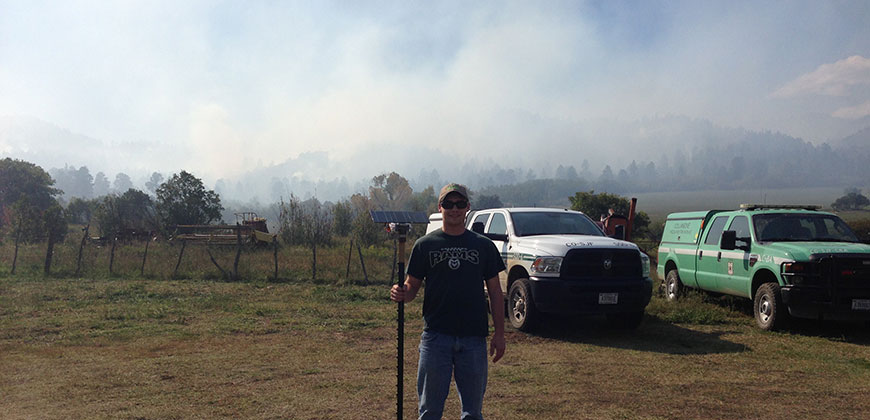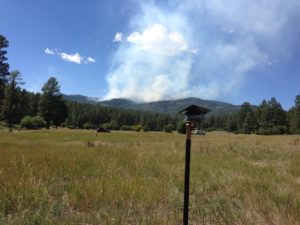
Master of engineering student Scott Kelleher spent two weeks in southern Colorado last month field-testing smoke emissions sensors.
Most people drive away from fires burning in the mountains. Scott Kelleher drives straight at them – well, near them, anyway. And it’s not for thrill seeking.
For two weeks in September, Kelleher drove the perimeter of a 6,000-acre prescribed burn in southern Colorado to set up 13 outdoor air samplers on steel stakes.
Kelleher’s system is suited for monitoring smoke emissions for both controlled burns and wildfires. Field-testing the sensors during an actual, unplanned wildfire would prove challenging. So, Kelleher received permission from the U.S. Forest Service to tag along on a planned, prescribed burn, which are common in the Rocky Mountains and other densely forested areas.
“The long-term goals of this project are very motivating,” Kelleher said. “It’s applying science and technology in an affordable new way to make the lives of those responsible for monitoring smoke much easier, with the main thought of protecting public health in mind.”
Field testing
Kelleher’s first field-testing campaign took place in a swath of land between Pagosa Springs and Bayfield, Colorado, near Pargin Mountain. Working closely with his contacts at the forest service, Kelleher set up each of his monitoring checkpoints in strategic proximity to the forest service’s monitoring zones.

The sensors Kelleher is testing are based off the principle of an Ultrasonic Personal Aerosol Sampler (UPAS) designed in the lab of his advisor, John Volckens, who is a professor in mechanical engineering and member of the CSU Partnership for Air Quality, Climate, and Health. The UPAS features an ultrasonic pump that draws in air, a sampling filter, rechargeable batteries, and an air flow rate sensor.
Kelleher’s master’s project involves adapting the UPAS for conditions suitable for prolonged outdoor monitoring. His new version, for which he is quick to point out he received many hours of help from other Volckens lab members, includes a hardened enclosure for weatherproofing; a solar cell for charging an extended-life battery; and a real-time, optical particle sensor that tracks the flow of particles 2.5 microns in diameter and smaller. “PM 2.5” is a standard measure for describing air pollution particles small enough to penetrate human lungs and cause health problems. The optical sampler contained in the device gives live updates.
The sensor also has a gravimetric analysis device that collects particles onto a filter. The filter is later weighed and analyzed for particulate matter concentrations. The entire device can be controlled remotely by smart phone.
The total cost of one of Kelleher’s sensors is estimated at about $500, compared with particulate matter monitors used today that cost $10,000 to $20,000. The standard sensors usually require line power, and are large – about the size of a microwave oven.
Kelleher’s unusual road trip involved seven rounds of 24-hour sampling. This involved traveling a route of 90 miles, changing out filters on each device and extracting information. In all, he was out in the fire for 14 days.
Automation in rural environments
A graduate of Montana Tech who grew up on a beef cattle, wheat and barley farm near the Canadian border, Kelleher is motivated by his work to bring the power of automation and monitoring to rural environments. Recognizing his penchant for engineering cost-effective solutions, and armed with his CSU master’s degree in a couple of years, Kelleher hopes he can make a difference by bringing simple automation technologies to farmers or small businesses.
The remainder of Kelleher’s thesis will involve organizing and analyzing the data he collected at Pargin Moutain as well as follow-up prescribed burn experiments as needed. He will present his recent findings at the Second International Smoke Symposium (ISS2) in Long Beach, California next month.
“It was very cool to observe such a large-scale event and learn about the processes and effort that go into it,” he said. “Hopefully, one day, my technology will enable anyone worried about air pollution to conduct monitoring right in their backyard.”